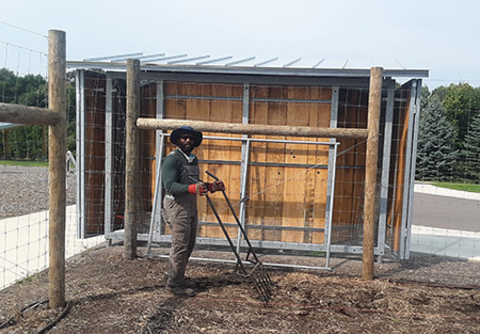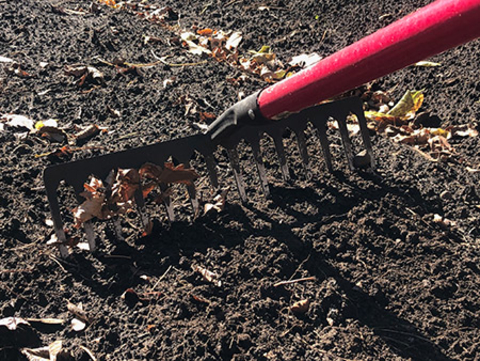Reducing tillage in your garden
UNIVERSITY OF MINNESOTA EXTENSION - www.extension.umn.edu
Tillage provides many useful services in the garden but can contribute negatively to soil health. Intensive tillage disrupts microbial communities and breaks up the soil structure. Over time, this leads to compaction, reduced water holding capacity and erosion.
Why reduce tillage?
We often talk about tilling as a yes or no question: to till, or not to till? However, it’s really more of a spectrum from no soil disturbance at all to intensive soil disturbance.
For many Minnesotans, especially people with large gardens, rototilling the garden every spring and fall is standard practice. While in the short term this provides many benefits, it has long-term consequences. Tillage essentially breaks the soil into smaller pieces, making it more susceptible to compaction and erosion. By reducing tillage, we can foster soil environments that are more diverse and resilient.
Tillage serves many purposes in a garden: creating an even seedbed, warming the soil in the spring, managing weeds, and working in debris and soil amendments. So, let’s look at each of these processes and how they can be achieved with other tools.
Starting a new garden
Clear plastic placed over a field to kill existing vegetation
The first step in starting a garden in a new space is removing existing vegetation. While a rototiller is an effective and quick way to do this, there are some excellent alternatives.
On a large scale, solarization and occultation can clear large areas for new gardens. The basic principle involves laying a sheet of plastic over the soil to prevent moisture (and in the case of occultation, light) from reaching the soil; the plants underneath eventually die, leaving a nice open area for planting. Read more about solarization and occultation.
On a smaller scale, simply using a sod ripper or a sharp flat-edge shovel is an effective way to remove grass. If you’re making a raised bed, the lasagna method is a great option. The lasagna method plays off of the idea of occultation, but instead of using plastic, you use cardboard to smother the grass underneath and bury it with layers of soil and organic materials to create a garden bed.
Reducing compaction
Farmer using a broadfork to reduce compaction in a new garden bed
Compaction is often a problem in new gardens, especially in areas that have been mowed with heavy riding lawn mowers for years. It can also be a problem in existing gardens.
In a new garden that’s extremely compact, tilling one time may be your best option. However, if the soil is relatively workable, or your goal is to reduce compaction in an existing garden, consider the following strategies.
Broadforking, or using a garden fork
A broadfork is an excellent tool for reducing compaction without breaking up aggregates in your soil. It consists of 3-5 metal tines on a horizontal bar, with two handlebars. The user steps on the horizontal bar, using their body weight to push the tines into the soil, then leans back to pull the tines through the soil. Broadforks are ergonomically designed to utilize your body weight rather than your brute force, and so they are easier on your body than a shovel or a regular garden fork. They aerate the soil without turning it over or breaking it into small pieces like a tiller would do.
Create permanent beds
A garden using a permanent bed system with mulch between beds
By creating permanent beds (either raised beds with wooden sides or simply mounded rows), you can limit your walking to between beds. This prevents compaction from your body weight on the beds. You can create beds by simply shoveling dirt into mounded rows, and raking it smooth. Often gardeners will use mulch or a low-growing cover crop such as clover between beds to help with water infiltration and to prevent mud build-up between rows.
Weed management
Tillage helps with weed management by breaking up perennial root systems and burying seed. However, it also brings weed seeds that were previously buried to the surface. As a result, in reduced tillage systems, we tend to see more perennial weeds over time, whereas in high disturbance systems, we see more annual weeds.
We can manage perennial weeds in a couple of ways. One is simply hand pulling weeds as soon as they emerge. This helps to deplete stored energy in the underground root system.
Solarization and occlusion can also be used before planting or after harvest. This may not fully kill perennial weeds, but it can help to interrupt their lifecycle and keep them from re-sprouting for a period of time.
Creating a smooth seedbed
A smooth, even seedbed is very helpful for planting small-seeded crops like carrots and lettuce. In a small garden bed, you can easily do this by hand, simply smoothing out the planting area with a rake or with hand tools prior to planting.
On a larger scale, especially when planting with machinery, this can be trickier. Many market gardeners use a tool called a tilther for this purpose. A tilther is a light-weight tiller that only tills the top two inches or so of soil. It’s still a form of tilling, but it’s much shallower, and thus less destructive to the deeper soil structure.
You can also use rakes to create even seedbeds, starting with a heavier rake to create a flat bed, and switching to a lighter rake, or even the flat, backside of a steel rake to smooth the surface.
Finally, consider whether you even need a smooth seedbed. If you’re transplanting most of your plants or using larger seeded plants like beans or pumpkins, you can get away with a less perfect seedbed.
Working in amendments
It’s important to continually replenish nutrients and organic matter to your soil. This could include working commercial fertilizers, compost or manure into the soil, or planting and incorporating a cover crop.
Tillage has been the standard way to do this for many gardeners, but there are plenty of alternatives. Two of the most popular have already been mentioned: tilthers and broadforks. These implements allow you to mix inputs into your soil without disrupting the full soil profile.
Make sure that you are adding amendments based on soil testing to ensure that you’re adding enough nutrients, but not too much.



